|
Part 1 - Part 2 - Part 3 - Part 4
As I've told ya'll before, people still ask me WHY I would want
to waste my time building a skin-on-frame boat when so many other
light and durable designs for plywood boats are available, besides
the fact I already have a slew of them! Well, ...my answer was,
"Cause I ain't never built one before!"
This one is my third! For
one thing they are fascinating works of art, packed full of history
from northern native tribes all over the world, and they certainly
ain't noth'n new!
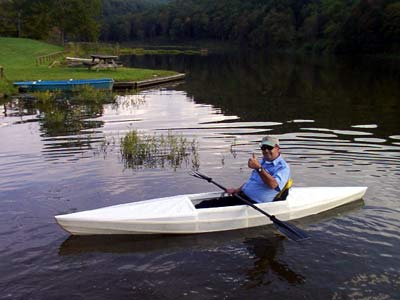
I'm not going to get into
the history, but you should please take some time and do a little
research on these highly sophisticated but simple watercraft.
Things that amazed me about these boats were indeed the simplicity
of the way they were and still are constructed, the stories about
Eskimos in cold northern waters going after seals, whales, walrus,
fish, etc. with a boat made from sticks, drift wood, tied together
with sinew then covered with some seal or walrus hide cause they
didn't have Home Depot to get wood, screws, glue, and they didn't
have any idea of what epoxy was!...and they didn't have a Jo Anne's
Fabric Store! The word "kayak" in Eskimo talk means
"hunting boat"!
Fewer tools are needed, less
material is needed and the methods are easy enough for almost
anyone to build a light and functional skin-on-frame canoe or
kayak. And as your project takes shape, they are easy to move
around without recruiting half the neighborhood for a Rollover
Party! My other two are 14 footers ...a good all around size for
general use; the attempt now was to build the lightest boat I've
ever made that would still do what I wanted it to.

Under 20 pounds!
My goal was to stay under
20 pounds! Oddly enough, LUCK was with me and I DID IT! I chose
a 12 footer with a purpose in mind, and that was for fishing and
again to have a light boat for grab'n go leisure paddling trips
around a lake or river.
The performance these boats
put out is incredible ...taking into consideration of "what"
they are made from! The ones I build could be labeled as a "decked
canoe", sometimes called kayaks and the hull shape is in
fact very much like a canoe. They could be made without a deck,
but the fabric deck does have the distinct advantage of keeping
cold water out of the boat and off the paddler as well as paddle
splash, and offers a little more security by enclosing the paddler.
Cockpit shapes and sizes can be left up to the individual's needs.
Both the 14 footers were
covered in cotton canvas, painted with plain ole latex house paint
...minimum 6 coats recommended and like I said, proved to be excellent
performers weighing 35 pounds or less!

my blue boat
My Blue boat is 35 lbs and
what I consider a little heavy due to the materials I had at hand.
The gray boat was about 5 pounds less. Stringers for her (the
Blue Boat) were made from treated yellow pine deck boards!...and
they were wet! Weight will depend on what you choose in the way
of materials for the frames as well as the stringers and floorboards.
My floors, made from 1/4" lauan,
are easily removed via 2 screws in each panel to make cleaning
and drying out easier.
Now back to the 12 footer
that I'll call my "BUG BOAT!" for certain reasons! I
chose to cover this boat with 850 denier ballistic nylon, and
coated it with a 2 part urethane varnish! This boat was strictly
experimental for the covering and coating....also twice as expensive
as the others! BUT, ...... after a lot of cussing from working
with the slick fabric that has to be cut with a very hot knife,
and even more cussing while applying the coating ...mostly because
of the bugs landing in it ......I finally got the hull completed.
The deck covering is temporary
and made from some small pieces of white tarp I had laying around
doing nothing. I'll finish the nice decks later and trim the boat
out to look a little better. Right now, I'm interested in what
the boat will do, how she will handle, and all that goes along
with testing a new boat for the first time. In other words, to
make sure the damn thing will float!
This covering and 2 part
urethane coating are tough as wet leather! Much stronger than
I anticipated! It was a pain in the ass like epoxy ...having to
mix up 3 batches in a 2:1 ratio applied in 3 wet coats! Get some
throwaway brushes!
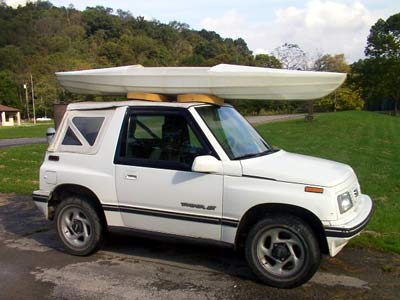
It took a full day to set
up and during that time ....bugs came from all over the damn country..
becoming a permanentdecoration on the WHITE hull! Nothing I could
do about most of them, but I did manage to pick a few of the bigger
ones out of the gooey mess! I figured since it was cool and breezy
with the sun shining brightly I'd have it made!
Well.....it didn't happen dat way! But you can bet yo ass the
next one will be covered and coated INSIDE!
Putting all that behind me
now, I wound up with a boat that looks like it's covered in a
durable translucent plastic...and a grave yard for various bugs!
The urethane completely penetrates the fibers which in turn gives
a coating on the inside of the boat ...unlike canvas where the
paint doesn't go all the way through the cloth! This stuff is
highly abrasion and puncture resistant - far beyond that of ordinary
canvas.
For the first time builder
of a skinboat, I would still recommend canvas and paint just to
keep the cost down. And use scraps ...yours, your neighbors ...anything
you can find suitable to build what you can, especially the frames!
There was no difference in the price between the nylon and cotton
canvas but a helluva lot of difference in price for the coating
as opposed to paint! We're talking a dollar an
ounce ..figure 60 ounces for each boat! As far as handling goes,
they perform as any multichine solo canoe! Easy to paddle, accelerate
quickly to a comfortable cruising speed, have a nice glide when
not paddling, and a larger cockpit is nice for fishing and general
use.
My plan was to use a Thermarest
seat cushion along with a stadium type or canoe seat to offer
some back support for my old bones. There are many plans available
for skin-on-frame kayaks, but I personally like the ones that
are the same shape on either end, or a symmetrical shape. A/C-D/C...is
one way to 'splain it! Don't matter which way you decide to get
in cause she'll go either way! I suppose there is a more proper
way to say that!.......
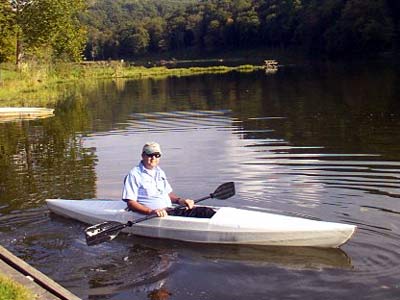
Whatever! What I'm trying
to tell you is that by having parts duplicated like the stems,
frames and all that simplifies construction! You ain't got to
be concerned other than the fact those two parts are close to
the same. Dat's another thing! You don't have to be so precise!
Mistakes are going to be made, and after 3 skinboats, I've made
a lot of them, but they are also easily corrected.
Once you have your frame
like you want it...kinda looking like a funny "hanging basket
or fish trap!", then it's just a matter of putting a dress
(Skin) on her! I've also found that just about any type of cloth
could be used to cover her delicate frame! Well let me tell you...the
old gal ain't that delicate! You have a rigid frame that is very
resilient and she will take some nasty bumps and bruises from
her flexibility! Not that you can see it with the naked eye, but
she does have a life of her own.
With canvas, a puncture is
easily repaired with a good ole Macgyver repair kit! Duck tape!
If you ram the boat into a snag, just put some duct tape over
the injured part and go on about your business. You can do a permanent
repair later if necessary with canvas, Marine Goop and a dab of
paint! The only time I damaged a skinboat was when the drill slipped
while installing a screw through the small rub rail and poked
a .38 caliber sized hole through the damn side before I even got
it to the water! Really pissed me off, but it was my own fault
for getting in a hurry!
Now for the good stuff.
The rain stopped and the sun came out for a very nice Indian type
summer afternoon. I waited for Shelby (my adopted grand daughter)
to get off the bus, so she could take pictures and have some fun.
We were at the lake in 5 minutes! We carried the little skinboat
on my little Geo Tracker, and unloading was a dream! I launched
her at the landing and you know something? There wasn't a damn
goose around anywhere! Hmmmmm...someth'ns up! I hate geese!
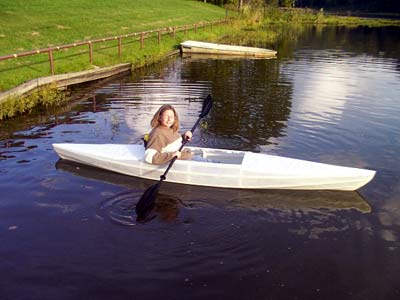
Shelby
The boat is very responsive,
super easy to maintain a cruising speed, and has a good glide.
She tracks well for such a short boat and maneuvers quicker than
the 14 footer. This is the boat I've been looking for! I like
it, I love it, I want some more of it! So I'll have to build another
one!
They...I say... they...will
be perfect for the Teardrop!
There's room for a day pack, fishing gear, a lunch box and other
goodies fore and aft and or between your legs. Took some getting
used to looking through the translucent hull at the water! Shelby
thought that part was cool! Her response to the boat was,"I
want one!" She also stated that this 12 foot skinboat was
the easiest she'd ever paddled.
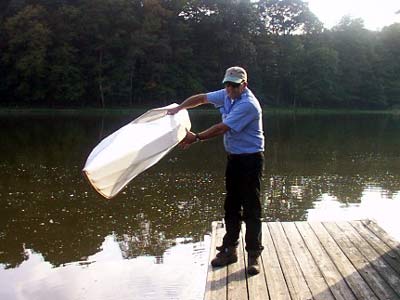
She's very, very light!
We both stayed dry, and as
you see as I took the little skinboat from the water at the landing,
she is very very light! As far as the coating and nylon skin goes?
I'll definitely use it again! It's very tough and even slicker
when wet! For a grab'n go recreational boat for fishing or just
playing around she rates an A+!
If you are in the 225 pound
range or larger, or want to go trekking for a week or so....go
with the 14 foot version, but for the average person 200 or less,
the 12 footer is fine! The 14 footer should weigh in at around
28 and not over 30 pounds!

And...I am working on my
own design that will be floating hopefully by Christmas! Yeah...I
know...it'll be cold as a bitch! But I'll be warm and dry in one
of these!
|

